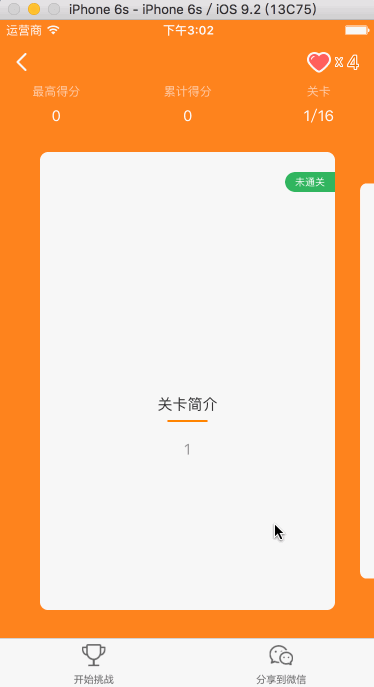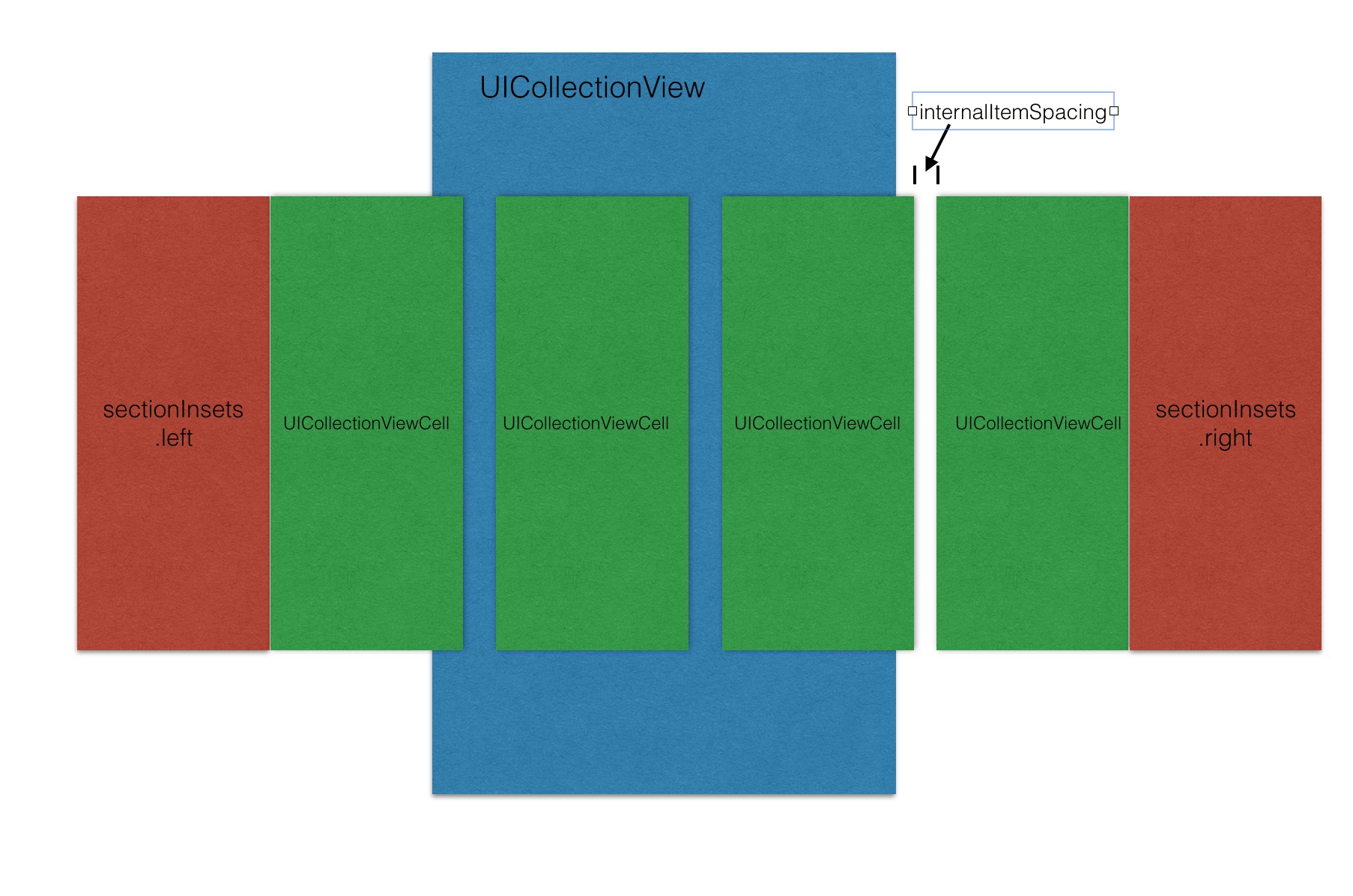一直以来想学习怎么样去自定义UICollectionViewLayout,但总是感觉太难,一直以来,都是看了一点点就放弃了。但其实任何事,只要去做了,就会发现,其实远没有想像的那么难。所以以后我遇事也要多动手。
废话说在前面
我之前尝试过去写这样一个关卡选择的功能,但是总是写不出来,后来同事用一个UIScrollView简单的写了一个,但是效果完全不给力,不但动画很生硬,而且没有复用机制。当关卡一多的时候,就会有很明显的卡顿,所以被我否决了。后来我想到了利用第三方库iCarousel来实现,但是并没有我所需要的效果,虽然可以自定义,但老实说我确实没有那种研究精神,而且我发现iCarousel与xib的结合使用似乎不太好。但出于简单省时的目的,我还是简单的修改了iCarousel的代码得到我需要的效果,但是同事却发现了其他的问题,于是最终还是决定自己实现一个,当然要实现这样的功能,当然是通过自定义UICollectionViewLayout来实现。本来我是在网上找资料,但是不知道是本性还是怎么,看一点就不想看下去了。我感觉没有一篇详细说明每个步骤的博文,所以决定把自己的实现过程纪录下来,供和我有同样需求的朋友参考。
效果展示
上面废话有点多,还是直接一点,上效果图吧。

效果虽然很简单,但基本也能概括自定义UICollectionViewLayout的必要步骤吧。
CustomCarCollectionViewFlowLayout类的定义
CustomCarCollectionViewFlowLayout其实如果继承自UICollectionViewFlowLayout会很简单的实现该效果,但是我之所以让其继承自UICollectionViewLayout的原因主要是有两点:1、我自己想利用这次机会好好学习一下自定义。2、继承自UICollectionViewFlowLayout很多方面都不好控制,而继承自UICollectionViewLayout完全自由,定义如下:
@interface CustomCardCollectionViewFlowLayout : UICollectionViewLayout
@property(nonatomic, assign) CGFloat internalItemSpacing;
@property(nonatomic, assign) CGSize itemSize;
@property(nonatomic, assign) UIEdgeInsets sectionEdgeInsets;
@property(nonatomic, assign) CGFloat scale;
@property(nonatomic, assign) NSInteger currentItemIndex;
@property(nonatomic, assign) id<CustomCardCollectionViewFlowLayoutDelegate> delegate;
@end
类说明
属性说明
internalItemSpacing
@property(nonatomic, assign) CGFloat internalItemSpacing;
这个属性其实是参考了UICollectionViewFlowLayout里面的minimumInterItemSpacing,该属性表示每个Cell之间的间隔,不过UICollectionViewFlowLayout里的是指最小的,可变的。而internalItemSpacing则不可变
itemSize
@property(nonatomic, assign) CGSize itemSize;
这个也是参考的UICollectionViewFlowLayout,该属性表示每个Cell的大小
sectionEdgeInsets
@property(nonatomic, assign) UIEdgeInsets sectionEdgeInsets;
还是参考的UICollectionViewFlowLayout,该属性表示每个section之间的间距
scale
@property(nonatomic, assign) CGFloat scale;
即表示左边或右边的Cell的缩放系数,当Cell走到最左边或最右边的时候将会被缩放成指定的大小。
currentItemIndex
@property(nonatomic, assign) NSInteger currentItemIndex;
表示当前在中央的Cell在UICollectionView中的索引,只有当Cell处于最中间的时候才会设置。
代理定义
CustomCardCollectionViewFlowLayoutDelegate的定义如下:
@class CustomCardCollectionViewFlowLayout;
@protocol CustomCardCollectionViewFlowLayoutDelegate <NSObject>
@optional
-(void)scrolledToTheCurrentItemAtIndex:(NSInteger)itemIndex;
@end
该代理中的方法,就是当UICollectionView滚动停止后,当前所在中间的Cell的索引,参考效果图上的关卡指示(1/16)。
代码说明
下面我将一步步按照自己的编写顺序来说明该功能的实现。
prepareLayout
prepareLayout是一个必须要实现的方法,该方法的功能是为布局提供一些必要的初始化参数,我的代码如下:
-(void)prepareLayout {
[super prepareLayout]
_itemsCount = [self.collectionView numberOfItemsInSection:0]
if(_internalItemSpacing == 0)
_internalItemSpacing = 5
if(_sectionEdgeInsets.top == 0 && _sectionEdgeInsets.bottom == 0 && _sectionEdgeInsets.left == 0 && _sectionEdgeInsets.right == 0)
_sectionEdgeInsets = UIEdgeInsetsMake(0, ([UIScreen mainScreen].bounds.size.width - self.itemSize.width) / 2, 0, ([UIScreen mainScreen].bounds.size.width - self.itemSize.width) / 2)
// UITapGestureRecognizer* tapGesture = [[UITapGestureRecognizer alloc] initWithTarget:self action:@selector(collectionViewTapped:)]
// [tapGesture setDelegate:self]
// [self.collectionView addGestureRecognizer:tapGesture]
return
}
- 1
- 2
- 3
- 4
- 5
- 6
- 7
- 8
- 9
- 10
- 11
- 12
- 13
- 14
- 15
- 16
- 17
- 1
- 2
- 3
- 4
- 5
- 6
- 7
- 8
- 9
- 10
- 11
- 12
- 13
- 14
- 15
- 16
- 17
首先是获取collectionView中共有多少个Cell,因为该功能一般只有一个section,所以我直接获取了section 0的数量。
其次是为该效果设置一些默认参数,如果用户没有提供值的话,将使用这些默认值。。
在最后有一个注释的UITapGestureRecognizer,这个手势本来是用来实现,点击两边的Cell能自动将点击的Cell滚动到中央。但是最后发现和UICollectionView的点击事件冲突了,导致滑动起来很吃力,到目前为止我还没想到更好的解决办法,于是只能暂时注释,慢慢想办法解决。也不妨将该手势的执行方法说一说。
手势处理
虽然手势不能使用,但还是可以拿来讲一讲,装装逼。其中有两段代码,一段是我处理手势冲突写的,但似乎效果不理想,最终还是没启用。
-(void)collectionViewTapped:(UIGestureRecognizer*)recognizer {
CGPoint location = [recognizer locationInView:self.collectionView];
NSIndexPath* indexPath = [self.collectionView indexPathForItemAtPoint:location];
if(indexPath == nil)
return ;
if(_currentItemIndex == indexPath.item) {
if([self.collectionView.delegate respondsToSelector:@selector(collectionView:didSelectItemAtIndexPath:)])
[self.collectionView.delegate collectionView:self.collectionView didSelectItemAtIndexPath:indexPath];
}
else {
_currentItemIndex = indexPath.item;
[self.collectionView setContentOffset:CGPointMake(indexPath.item * (_internalItemSpacing + _itemSize.width), 0) animated:YES];
if([self.delegate respondsToSelector:@selector(scrolledToTheCurrentItemAtIndex:)])
[self.delegate scrolledToTheCurrentItemAtIndex:_currentItemIndex];
}
return ;
}
- 1
- 2
- 3
- 4
- 5
- 6
- 7
- 8
- 9
- 10
- 11
- 12
- 13
- 14
- 15
- 16
- 17
- 18
- 19
- 20
- 21
- 1
- 2
- 3
- 4
- 5
- 6
- 7
- 8
- 9
- 10
- 11
- 12
- 13
- 14
- 15
- 16
- 17
- 18
- 19
- 20
- 21
该方法是先获取到点击点在collectionView中的坐标,然后对应到点击的Cell的indexPath,当点击的Cell位于中间的话,则调用原来collectionView的didSelectItemAtIndexPath:方法,否则,调用setContentOffset方法,设置将点击的Cell设置到中间位置。
还有一个是处理手势冲突的,如下:
-(BOOL)gestureRecognizer:(UIGestureRecognizer *)gestureRecognizer shouldReceiveTouch:(UITouch *)touch {
CGPoint location = [touch locationInView:self.collectionView];
NSIndexPath* indexPath = [self.collectionView indexPathForItemAtPoint:location];
if(indexPath == nil || indexPath.item == _currentItemIndex)
return NO;
return YES;
}
该方法是UIGestureRecognizerDelegate里的代理方法,同样的先获取到点击的indexPath,如果没有点击在Cell上或者点击了中间项,就不响应点击手势。但是效果并不理想,目前项目紧张也暂时不去考虑这么多了。
collectionViewContentSize
顾名思义,该方法也是一个必写的方法,该方法返回了collectionView的contentSize,我的代码如下:
-(CGSize)collectionViewContentSize {
CGFloat contentWidth = _sectionEdgeInsets.left + _sectionEdgeInsets.right + _itemsCount * _itemSize.width + (_itemsCount - 1) * _internalItemSpacing
CGFloat contentHeight = _sectionEdgeInsets.top + _sectionEdgeInsets.bottom + self.collectionView.frame.size.height
return CGSizeMake(contentWidth, contentHeight)
}
那么collectionView的contentSize应该是多少呢?根据代码,我们知道height可以设置为0,因为需要纵向滚动,横向呢?

从图中我们可以很明显的看出来,宽度应该是 『左边间距 + Cell数 * Cell宽度 + (Cell数 - 1) * Cell间距 + 右边间距』。
layoutAttributesForItemAtIndexPath:方法
该方法也是一个必须要实现的方法,该方法是为每个Cell返回一个对应的Attributes,我们需要在该Attributes中设置对应的属性,如Frame等,代码如下:
-(UICollectionViewLayoutAttributes *)layoutAttributesForItemAtIndexPath:(NSIndexPath *)indexPath {
UICollectionViewLayoutAttributes* attr = [UICollectionViewLayoutAttributes layoutAttributesForCellWithIndexPath:indexPath]
attr.size = _itemSize
attr.frame = CGRectMake((int)indexPath.row * (_itemSize.width + _internalItemSpacing) + _sectionEdgeInsets.left, (self.collectionView.bounds.size.height - _itemSize.height) / 2 + _sectionEdgeInsets.top, attr.size.width, attr.size.height)
return attr
}
首先调用”layoutAttributesForCellWithIndexPath:类方法创建一个Attributes,然后设置对应cell的frame,最后再返回该Attributes。
layoutAttributesForElementsInRect:
该方法是为在一个rect中的Cell返回Attributes,我们必须在该方法中做相应的处理,才能实现相应的效果。代码如下:
-(NSArray<UICollectionViewLayoutAttributes *> *)layoutAttributesForElementsInRect:(CGRect)rect {
NSMutableArray* attributes = [NSMutableArray array]
CGRect visiableRect = CGRectMake(self.collectionView.contentOffset.x, 0, self.collectionView.bounds.size.width, self.collectionView.bounds.size.height)
CGFloat centerX = self.collectionView.contentOffset.x + [UIScreen mainScreen].bounds.size.width / 2
for (NSInteger i=0
NSIndexPath* indexPath = [NSIndexPath indexPathForItem:i inSection:0]
UICollectionViewLayoutAttributes* attr = [self layoutAttributesForItemAtIndexPath:indexPath]
[attributes addObject:attr]
if(CGRectIntersectsRect(attr.frame, visiableRect) == false)
continue
CGFloat xOffset = fabs(attr.center.x - centerX)
CGFloat scale = 1 - (xOffset * (1 - _scale)) / (([UIScreen mainScreen].bounds.size.width + self.itemSize.width) / 2 - self.internalItemSpacing)
attr.transform = CGAffineTransformMakeScale(scale, scale)
}
return attributes
}
- 1
- 2
- 3
- 4
- 5
- 6
- 7
- 8
- 9
- 10
- 11
- 12
- 13
- 14
- 15
- 16
- 17
- 18
- 19
- 20
- 21
- 1
- 2
- 3
- 4
- 5
- 6
- 7
- 8
- 9
- 10
- 11
- 12
- 13
- 14
- 15
- 16
- 17
- 18
- 19
- 20
- 21
首先,调用我们实现的layoutAttributesForItemAtIndexPath:方法,为每个Cell设置一个Attributes,然后遍历Attributes集,如果Cell没有和当前返回的rect相交,那么我们不用去处理,因为反正我们也看不到。否则设置scale,至于scale的计算,数学能力强的很容易写出来,我搞了好久,因为从小到大,数学就TM菜的一逼。最后设置transform进行缩放。
shouldInvalidateLayoutForBoundsChange:
该方法中,需要返回YES,当滚动的时候,重新生成对应属性
-(BOOL)shouldInvalidateLayoutForBoundsChange:(CGRect)newBounds {
return YES;
}
targetContentOffsetForProposedContentOffset:withScrollingVelocity:
该方法的作用是当UICollectionView停止滚动时,用户希望停止在哪个位置上,对于该方法,我的代码如下所示:
-(CGPoint)targetContentOffsetForProposedContentOffset:(CGPoint)proposedContentOffset withScrollingVelocity:(CGPoint)velocity {
NSInteger itemIndex = (NSInteger)(self.collectionView.contentOffset.x / (_itemSize.width + _internalItemSpacing));
CGFloat xOffset = itemIndex * (_internalItemSpacing + _itemSize.width);
CGFloat xOffset_1 = (itemIndex + 1) * (_internalItemSpacing + _itemSize.width);
if(fabs(proposedContentOffset.x - xOffset) > fabs(xOffset_1 - proposedContentOffset.x)) {
_currentItemIndex = itemIndex + 1;
if([self.delegate respondsToSelector:@selector(scrolledToTheCurrentItemAtIndex:)])
[self.delegate scrolledToTheCurrentItemAtIndex:_currentItemIndex];
return CGPointMake(xOffset_1, 0);
}
_currentItemIndex = itemIndex;
if([self.delegate respondsToSelector:@selector(scrolledToTheCurrentItemAtIndex:)])
[self.delegate scrolledToTheCurrentItemAtIndex:_currentItemIndex];
return CGPointMake(xOffset, 0);
}
- 1
- 2
- 3
- 4
- 5
- 6
- 7
- 8
- 9
- 10
- 11
- 12
- 13
- 14
- 15
- 16
- 17
- 18
- 1
- 2
- 3
- 4
- 5
- 6
- 7
- 8
- 9
- 10
- 11
- 12
- 13
- 14
- 15
- 16
- 17
- 18
首先,我根据偏移量计算出对应的当前Cell的index,然后分别获取到当前Cell和下一个Cell的偏移量,然后判断屏幕中央隔哪边比较近,就将哪一个调整到中间。最后修改中央Cell的index,调用结束之后的代理方法。
使用方法
至此,自定义UICollectionViewLayout就已经全部结束,其使用方法也和UICollectionViewFlowLayout差不多,我的使用代码如下:
((CustomCardCollectionViewFlowLayout*)self.m_pCollectionView.collectionViewLayout).itemSize = CGSizeMake(UI_IOS_WINDOW_WIDTH - 80, UI_IOS_WINDOW_HEIGHT - 64 - 40 - 105)
((CustomCardCollectionViewFlowLayout*)self.m_pCollectionView.collectionViewLayout).scale = 0.85f
((CustomCardCollectionViewFlowLayout*)self.m_pCollectionView.collectionViewLayout).delegate = self
关于UICollectionView的部分是在xib中设置的,没有相关代码,因为很多默认值都是根据我的项目需要来设置的,所以我这里只设置了itemSize和scale缩放系数这两个参数。效果就如上图所示。。
结束语
其实自定义一个布局真的不算太难,最难的点在于数学模型的建立,但是只要有决心,相信自己,用心钻研,也一定能搞定难题。虽然我不是这种人,但是原本我觉得很难,但这次无可奈何的情况下,只能硬着头皮去做,结果发现是我自己把事情想复杂了。所以最后再来一句:不要想,就是干。
代码链接
github代码链接

